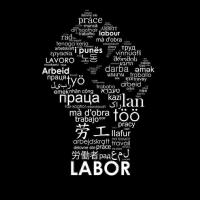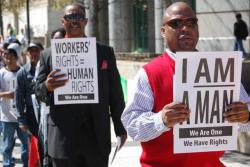 Issued by the Emergency Labor Network (ELN)-February 8, 2012
Issued by the Emergency Labor Network (ELN)-February 8, 2012
The hype is on again in the press that recovery is around the corner. Last month’s jobs numbers are cited as the latest proof of recovery. The economic data puffery will no doubt prove intense in this election year, but a closer look at the facts should temper the false confidence.
After more than four years following the start of the recession in December 2007, and three years after President Obama assumed office, the crisis in jobs in the United States continues as the number one problem of the U.S. economy.
Based on the U.S. Department of Labor’s more accurate latest “U-6” unemployment rate, at the official end of the recession in June 2009 there were 25.4 million jobless; today, more than 30 months later, there still remain 23.4 million without work. That’s a total of only about 67,200 jobs created a month over two and a half years — a monthly number barely half of what is needed to even absorb new entrants into the labor force each month.
Most of the 2 million jobs created in the private sector since President Obama assumed office three years ago have been lower-paid service jobs, part-time jobs, and temporary forms of employment – nearly all of them providing lower wages and fewer benefits. Higher-paying and benefit jobs in manufacturing and construction have, in contrast, continued to decline since the June 2009 recession low-point. There were 21.1 million manufacturing and construction jobs when the recession began in 2008. There are only 17.3 million manufacturing and construction jobs today.
Unlike all previous 11 recessions in the United States since 1945, the government sector has not created jobs to offset private sector job loss during the recession. Government instead has become a major contributor to job destruction. Local governments have laid off 643,000 workers since June 2009, nearly a quarter million — 247,000 — of whom have been teachers. Public workers and teachers continue to be laid off at a rate of 20,000 or more a month. At that pace, by the end of his first term, President Obama may have presided over a loss of nearly a million public workers’ jobs.
Other indicators of the continuing sad state of the jobs markets in the United States after three years further corroborate the continuing crisis of jobs in this country. For example, the duration of long-term unemployed — i.e., those out of work 27 or more weeks — has continued to rise steadily since June 2009, from 24% of all those unemployed to more than 40% today. Meanwhile, millions of workers have left the jobs market, having given up on the prospect of finding work.
Another indicator of the continuing severity of today’s jobs crisis, the “Employment to Population Ratio” that measures how well the economy is creating jobs in relation to the growth of population, shows the U.S. economy is growing fewer and fewer jobs as the U.S. population rises. At the start of the current recession, 63% of the U.S. population was employed; today only 58.5% of the U.S. population has jobs. And there are still 4.2 workers looking for every job offered today — i.e. well more than double the 1.8 to 1 ratio that existed before the recession began.
The jobs creation programs offered by the Obama administration and Congress over the past three years have proved dismally inadequate. In January 2009 the Obama administration promised to create six million jobs if its first stimulus program costing $787 billion were passed by Congress, 40% of which were tax cuts. In June 2009 there were approximately 25 million unemployed. By mid-summer 2010 there were still 25 million unemployed and job losses began to rise again that summer.
While the Democrats have thus far failed to provide any effective programs to restore the millions of jobs lost since the recession began, Republicans continue to propose the same old retread solutions that destroyed millions of jobs over the past decade. Republicans continue to propose more tax cuts for corporations and wealthy investors, more cuts to social programs, and a further expansion of military spending. These programs not only have failed to produce jobs, but actually have eliminated them by the millions over the past decade.
Moreover, whenever the Obama administration has proposed any kind of job creation program, the Republicans have been quick to denounce it and deadlock Congress so that nothing can get done.
If big banks and big business refuse to use their bailed out $4 trillion cumulative cash hoard of the past three years to create jobs, then the government must tax it or take it back from them and use it to create jobs itself. The United States needs a 21st century version of the 1930s depression-era New Deal jobs programs, adapted from the past to present conditions. What the U.S. economy specifically needs is the immediate creation of a Civilian Conservation Corps (CCC) program similar to that created in 1933. In just 90 days the CCC created the equivalent of what would be 1.2 million jobs in today’s economy. What the economy also needs now is a new 21st century Works Progress Administration (WPA) that during the period 1935 to 1940 created the equivalent of what would be 25 million jobs today.
The $4 trillion to fund these direct job creation programs are there. There’s no need to raise the deficit or debt. If the super-wealthy and their big corporations and banks won’t spend the trillion dollar bailouts they were provided by U.S. taxpayers to invest in America and create jobs, then the only alternative is for the government to reclaim those trillions and spend them on a public program to create jobs.
The Emergency Labor Network from its inception has urged organized labor to mobilize massive numbers of people to demand that the government implement a jobs program to put all of the unemployed back to work.
And consider what it would mean if the labor movement had its own independent political party, supported by tens of millions of allies among unorganized and low-income workers, the unemployed, communities of color, students and other youth, the women’s movement, immigrants, and other progressive sections of the population. Such a party would be projecting a program of jobs for all, bailing out the people and not the banks, redirecting astronomical military spending to meet human needs, and rebuilding a crumbling infrastructure that is critically in need of repair.
Isn’t it time for those of us in labor to engage in a serious discussion on the need to establish such a party?
— Issued by the Emergency Labor Network (ELN)
For more information write to emergencylabor@aol.com or P.O. Box 21004, Cleveland, OH 44121 or call 216-736-4715 or visit our website at http://www.laborfightback.org. Donations gratefully accepted. Please make checks payable to ELN and mail to above P.O. Box.


 With the passage of Senate Bill 727 today in the NC State Senate, we are seeing an escalation of the attacks on workers and our organizations. Activists have expressed a need for unity and bold action now more than ever to help fight back this vicious tide.
With the passage of Senate Bill 727 today in the NC State Senate, we are seeing an escalation of the attacks on workers and our organizations. Activists have expressed a need for unity and bold action now more than ever to help fight back this vicious tide.

